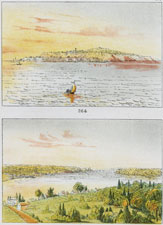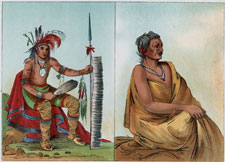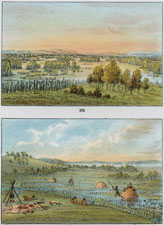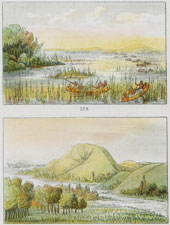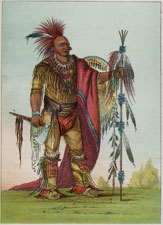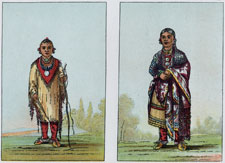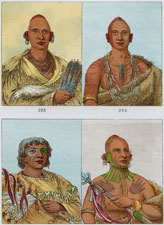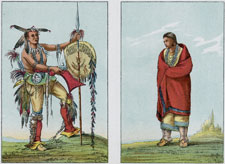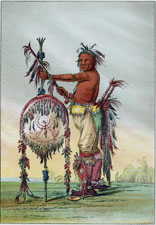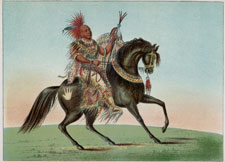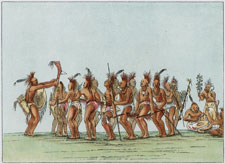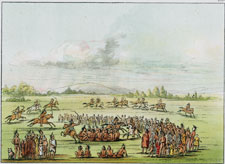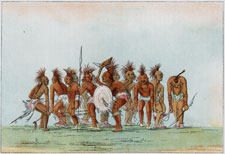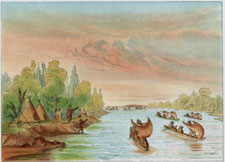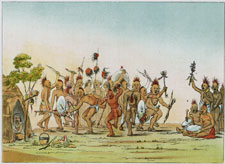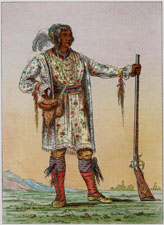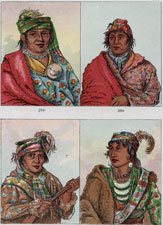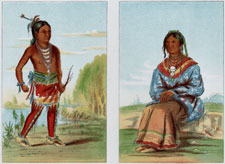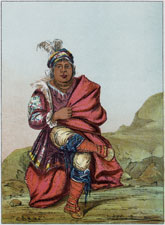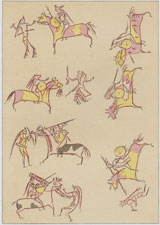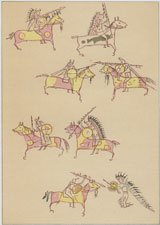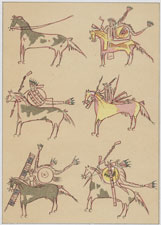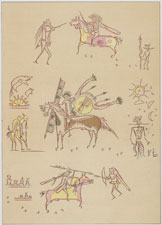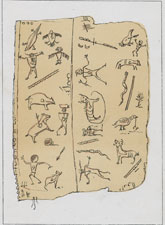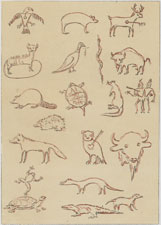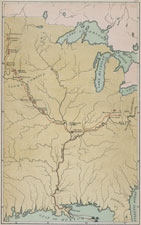Illustrations of the Manners, Customs, & Condition of the |
|||||||||
|---|---|---|---|---|---|---|---|---|---|
George Catlin's paintings comprise the first important pictorial record of the Plains Indians and their then little-known homelands west of the Mississippi River. "Catlin's Indian Gallery," as the dedicated artist himself called it, consisted of hundreds of portraits of Indians, scenes of Indian life, and landscapes of a wilderness scarcely changed through the millennia. In his notebooks and on canvas, the young Pennsylvania lawyer captured much of an American that was swept away a century ago by the westward-pressing settler. Catlin made these dramatic paintings on a series of journeys into largely unmapped Indian country between 1830 and 1836. For the first time, Americans in the eastern states saw the Pawnees, the tall Blackfeet and Crows, the Sioux, and the wild Comanches. They saw wide prairies teeming with buffalo, the turbulent Missouri River, and the giant grizzly bear. They saw villages of hundreds of graceful teepees and peered into the dim interiors of comfortable earth lodges, and witnessed the four-day torture ceremony of the Mandans. The Plains Indians of Catlin's portraits were still proud and dignified, unlike their cousins on eastern reservations. Freed by the acquisition of the horse from the restrictions of hunger and scarcity, they were riding the crest of a new richness and power. But they, too, were fated to lose in the encounter with western civilization—and Catlin knew it. "Art may mourn when these people are swept from the earth," he wrote, "and the artists of the future ages may look in vain for another race so picturesque in their costumes, their weapons, their colours, their manly games, and their chase...." [ref.: "Letters and Notes..." introduction by Marjorie Halpin (Dover, 1973).] |
George Catlin "I sat out alone, unaided and unadvised, resolved, (if my life should be spared), by the aid of my brush and my pen, to rescue from oblivion so much of their primitive looks and customs as the industry and ardent enthusiasm of one lifetime could accomplish." GEORGE CATLIN, ca. 1842
|
||||||||
| PLEASE CLICK ON A THUMBNAIL FOR AN ENLARGED VIEW (Colors represented on individual computer monitors will vary and may not accurately depict the actual lithographic color on the prints.) |
|||||||||
Sault Ste. Marie from the Canadian Shore |
Gitch-ee-gaw-ga-osh, Point That Remains Forever |
Pipe Stone Quarry |
|||||||
Mah-to-che-ga, Little Bear Tah-teck-a-da-hair, Steep Wind, brother of The Dog Shon-ka, The Dog |
Swan Lake Catching Muskrats |
Sioux gathering wild rice Banks of the St. Peters River near the Traverse de Sioux
|
|||||||
Kee-o-kuk, The Running Fox |
Wife of Kee-o-kuk Favorite son of Kee-o-kuk |
Muk-a-tah-mish-o-kah-kaik, Black Hawk Nah-se-us-kuk, Whirling Thunder, son of Black Hawk Wah-pe-kee-suck, White Cloud Wee-sheet, Sturgeon's Head |
|||||||
Ah-mou-a, The Whale Wa-quo-tha-qua, Buck's Wife or Female Deer |
Pash-ee-pa-ho, Little Stabbing Chief |
Keokuk on horseback |
|||||||
Slave Dance |
"Smoking horses," Fox going to war beg horses from the Sauk |
Begging Dance |
|||||||
Sailing in canoes with the aid of blankets |
Discovery Dance |
Dance to the berdash (i-coo-coo-a) |
|||||||
Dance to the medicine-bag of the brave |
Osceola, Black Drink |
Ye-how-lo-gee, The Cloud Ee-mat-la, King Phillip Co-ee-ha-jo La-shee, the Licker, commonly called "Creek Billy" |
|||||||
Osceola Nick-a-no-chee, Seminole boy Seminole woman |
Mick-e-no-pah |
||||||||
Decorations on Crow robes in Catlin's collection |
Decorations on Crow robes in Catlin's collection |
Outlines on a Pawnee robe in Catlin collection |
|||||||
Outlines on a Pawnee robe in Catlin collection |
An Indian song on birch bark in the Catlin collection |
Symbolic writings and totems |
|||||||
|
 |
||||||||
|
|||||||||
| Click here to return to the Native American homepage | |||||||||


